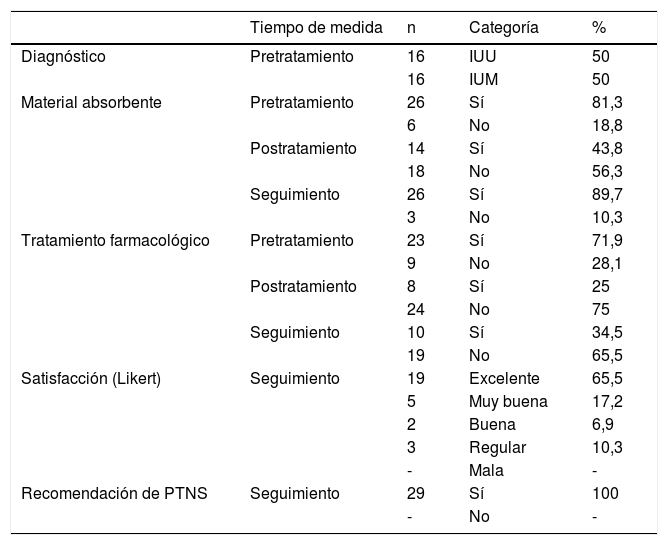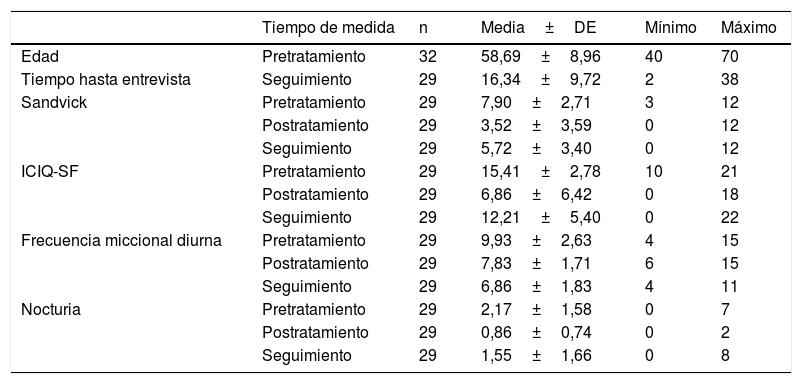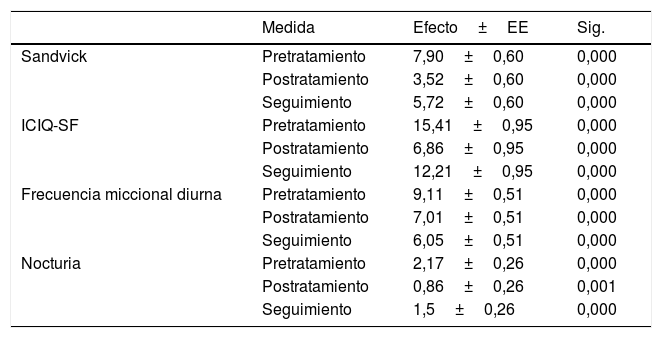Evaluar la eficacia de la estimulación percutánea del nervio tibial y su efectividad mantenida en el tiempo en la incontinencia urinaria de urgencia.
Materiales y métodoSe efectuó un diseño longitudinal observacional prospectivo sin grupo control, cuyos sujetos fueron los pacientes con incontinencia urinaria de urgencia que cumplían los criterios de inclusión y exclusión. Se realizaron 12 sesiones de estimulación percutánea del nervio tibial mediante electroacupuntura. Los datos de la situación basal y postratamiento fueron recogidos mediante historias clínicas y se les evaluó tiempo después mediante entrevista telefónica. Se registraron variables sociodemográficas, tiempo hasta entrevista, cuestionarios Sandvick e ICIQ-SF, frecuencia miccional diurna, nocturia, material absorbente y uso de tratamiento farmacológico. Se realizó análisis descriptivo de las variables y se analizó la evolución de los pacientes mediante modelos mixtos lineales generalizados, utilizando el paquete estadístico SPSS v. 25.
ResultadosTreinta y dos mujeres con 58,69±8,96 años. Todas las variables mejoraron tras el tratamiento significativamente: Sandvick 4,38 puntos (IC 95%: 2,68-6,08, p<0,001), ICIQ-SF 8,55 puntos (IC 95%: 5,89-11,22, p<0,001), frecuencia miccional diurna 2,10 puntos (IC 95%: 1,04-3,16, p<0,001) y nocturia 1,31 puntos (IC 95%: 0,58-2,04, p<0,001). Sin embargo, en entrevista tras 16,34±9,72 meses después del tratamiento, empeoraron ligeramente sin alcanzar los valores basales.
ConclusionesLa estimulación percutánea del nervio tibial mediante electroacupuntura es eficaz para el tratamiento de la incontinencia urinaria de urgencia. Aunque su efecto disminuye con el tiempo, la mejoría respecto de la situación basal se mantiene durante el periodo de seguimiento.
To assess the efficacy of percutaneous tibial nerve stimulation and its effectiveness over time in urge urinary incontinence.
Materials and methodsWe performed a longitudinal, observational, prospective study without a control group that included patients diagnosed with urge urinary incontinence who met the inclusion/exclusion criteria. Patients were treated with 12 sessions of percutaneous tibial nerve stimulation by electroacupuncture. Baseline and post-treatment data were collected from medical records. Patients were assessed by a telephone interview after the treatment. The variables studied were sociodemographic variables, time until interview, the Sandvick and ICIQ-SF questionnaires, daytime urinary frequency, night-time urinary frequency, use of absorbent material and drug treatment. A descriptive analysis of the variables was performed and patient outcomes were analysed with generalised linear mixed models by SPSS v. 25 statistics software.
ResultsA total of 32 women were included (mean age 58.69±8.96). All variables significantly improved after treatment: Sandvick by 4.38 points (95% CI: 2.68-6.08, P<.001), ICIQ-SF by 8.55 points (95% CI: 5.89-11.22, P<.001), daytime urinary frequency by 2.10 points (95% CI: 1.04-3.16, P<.001) and night-time urinary frequency by 1.31 points (95%CI: 0.58-2.04, P<.001). However, 16.34±9.72 months after treatment, these improvements diminished but without reaching baseline levels.
ConclusionsPercutaneous tibial nerve stimulation by electroacupuncture is effective for the treatment of urge urinary incontinence. Although its effect diminishes over time, the improvement over the baseline situation is maintained during the follow-up period.












